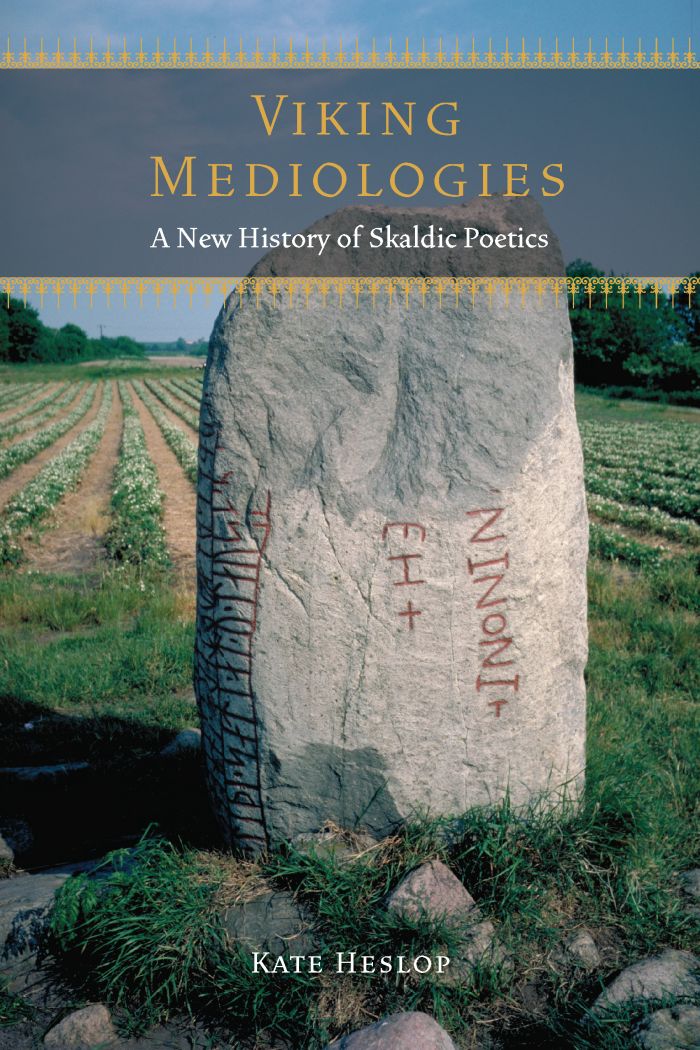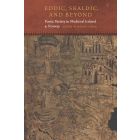Viking Mediologies
A New History of Skaldic Poetics

This book can be opened with

WINNER, ALDO AND JEANNE SCAGLIONE PRIZE FOR STUDIES IN GERMANIC LANGUAGES AND LITERATURES
Viking Mediologies is a study of pre-modern multimedia rooted in the embodied poetic practice of Viking Age skalds. Prior study of the skaldic tradition has focused on authorship—distinctions of poetic style, historical contexts, and attention to the oeuvres of the skalds whose names are preserved in the written tradition. Kate Heslop reconsiders these not as texts but as pieces in a pre-modern media landscape, focusing on poetry’s medial capacity to embody memory, visuality, and sound.
Mobile, hybrid, diasporic social formations—bands of raiders and traders, petty kingdoms, colonial expeditions—achieved new prominence in the Viking Age. Skalds offered the leaders of these groups something uniquely valuable. With their complicated poetry, they claimed to be able to capture shared contingent meanings and re-mediate them in named, memorable, reproducible works. The commemorative poetry in kviðuháttr remembers histories of ruin and loss. Skaldic ekphrasis discloses and reproduces the presence of the gods. Dróttkvætt encomium evokes for the leader’s retinue the soundscape of battle.
As writing arrived in Scandinavia in the wake of Christianization, the media landscape shifted. In the poetry of the twelfth and thirteenth centuries, skalds adjusted to the demands of a literate audience, while the historical and poetological texts of the Icelandic High Middle Ages opened a dialogue between Latin Christian ideas of mediation and local traditions. In the Second Grammatical Treatise, for example, the literate technology of the grid is used to analyze the complex resonances of dróttkvætt as the output of a syllable-spewing hurdy-gurdy—a poetry machine.
Offering both new readings of both canonical works such as Ynglingatal, Ragnarsdrápa, and Háttatal, and examinations of lesser-known texts like Glymdrápa, Líknarbraut, and Sturla Þórðarson’s Hákonarkviða, Viking Mediologies explores the powers and limits of poetic mediation.
In Viking Mediologies, Kate Heslop approaches skaldic texts through a wholly new interpretive framework. She repositions the texts, opening them up to larger and vital interdisciplinary questions about the poems’ place in Viking and medieval Scandinavian culture. Quite simply, this is one of the most exhilarating and provocative books about Old Norse literature and culture that it has ever been my privilege to read.—Carolyne Larrington, University of Oxford
In this profoundly erudite and beautifully written book, Kate Heslop shows us that skaldic verse-- like, indeed, much other poetry--acts as intermediary between lived experience as witnessed (according to the claims of the poet) by the composer of the verse, and the imagination of the verse’s audience.... This is a wonderful book. Read it.—Shami Ghosh, The Medieval Review
Kate Heslop’s Viking Mediologies is an ambitious and well-written book demonstrating on nigh every page a fiery intellect. It is bound to stimulate the curious reader and will surely rank as one of the most important and influential Old Norse studies from the first part of this century.—Journal of English and Germanic Philology
. . .[I]mpressive in the truest sense of the word, in that it will leave an impression not only on its readers but also on the scholarly landscape of skaldic poetics. . . Heslop encourages and challenges us to think carefully about how we approach skaldic poetry as a medium, with which senses we do so, and how these questions might ultimately help us think about memory, reading and voice.—Saga
General Abbreviations | vii
Abbreviations for Poets and Poems | ix
Acknowledgments | xiii
Introduction | 1
Part 1: Making Memories
Rök and Ynglingatal | 15
1. Death in Place | 20
2. Forging the Chain | 46
Stone—Stanza—Memory | 72
Part 2: Seeing Things
3. The Viking Eye | 81
4. Seeing, Knowing, and Believing in the Prose Edda | 108
Part 3: Hearing Voices
5. The Noise of Poetry | 135
6. A Poetry Machine | 160
Conclusion | 185
Notes | 193
References | 257
Index | 291
Plates follow page 78


